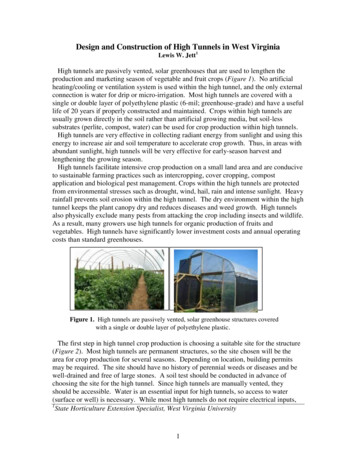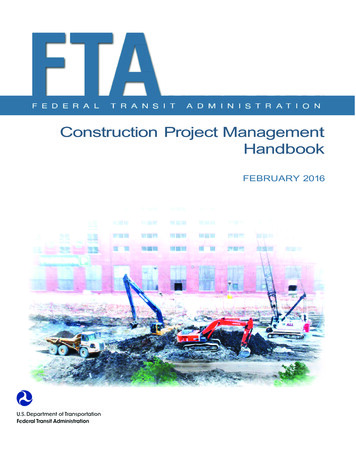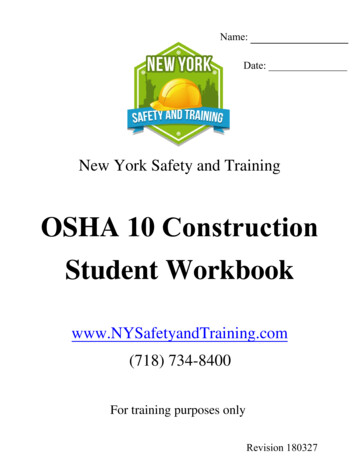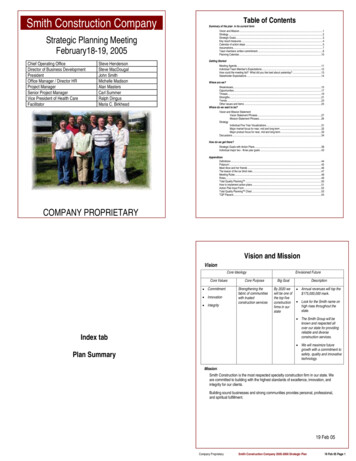
Transcription
Design and Construction of High Tunnels in West VirginiaLewis W. Jett1High tunnels are passively vented, solar greenhouses that are used to lengthen theproduction and marketing season of vegetable and fruit crops (Figure 1). No artificialheating/cooling or ventilation system is used within the high tunnel, and the only externalconnection is water for drip or micro-irrigation. Most high tunnels are covered with asingle or double layer of polyethylene plastic (6-mil; greenhouse-grade) and have a usefullife of 20 years if properly constructed and maintained. Crops within high tunnels areusually grown directly in the soil rather than artificial growing media, but soil-lesssubstrates (perlite, compost, water) can be used for crop production within high tunnels.High tunnels are very effective in collecting radiant energy from sunlight and using thisenergy to increase air and soil temperature to accelerate crop growth. Thus, in areas withabundant sunlight, high tunnels will be very effective for early-season harvest andlengthening the growing season.High tunnels facilitate intensive crop production on a small land area and are conduciveto sustainable farming practices such as intercropping, cover cropping, compostapplication and biological pest management. Crops within the high tunnels are protectedfrom environmental stresses such as drought, wind, hail, rain and intense sunlight. Heavyrainfall prevents soil erosion within the high tunnel. The dry environment within the hightunnel keeps the plant canopy dry and reduces diseases and weed growth. High tunnelsalso physically exclude many pests from attacking the crop including insects and wildlife.As a result, many growers use high tunnels for organic production of fruits andvegetables. High tunnels have significantly lower investment costs and annual operatingcosts than standard greenhouses.Figure 1. High tunnels are passively vented, solar greenhouse structures coveredwith a single or double layer of polyethylene plastic.The first step in high tunnel crop production is choosing a suitable site for the structure(Figure 2). Most high tunnels are permanent structures, so the site chosen will be thearea for crop production for several seasons. Depending on location, building permitsmay be required. The site should have no history of perennial weeds or diseases and bewell-drained and free of large stones. A soil test should be conducted in advance ofchoosing the site for the high tunnel. Since high tunnels are manually vented, theyshould be accessible. Water is an essential input for high tunnels, so access to water(surface or well) is necessary. While most high tunnels do not require electrical inputs,1State Horticulture Extension Specialist, West Virginia University1
some growers choose to have electric fans which circulate air or inflate air betweendouble layers of polyethylene.High tunnels do not have to be constructed on perfectly level land, but a building pad orterrace can be made prior to constructing the high tunnel. Slope along the length of thehigh tunnel will facilitate water movement but should not be greater than 3%. Slopeacross the width of the high tunnel can be compensated by adjusting the height of theground posts on either side. The construction pad can have sloping sides to channelwater and snow runoff from the high tunnel structure.The site should have full sun and good air flow since these are essential inputs to howwell a high tunnel functions. Low areas that accumulate cold air (frost pockets) and wateror sites close to a tree line or other structures which may cast a shadow on the high tunnelstructure should be avoided. Also, areas with strong wind should have a wind break toprevent excessive wind stress or snow accumulation against the structure.Figure 2. The site for construction of a high tunnel should be accessible, well-drainedwith abundant sunlight. (Photo Credit: E. Coleman)Orientation or positioning of the high tunnel is site dependent. The primary criterionshould be maximizing passive ventilation. Therefore, for suitable ventilation, the hightunnel should be oriented so the length of the structure is perpendicular (i.e., at rightangles) to prevailing winds at the site. In West Virginia, a north-south orientation isoptimal for cross ventilation. Above the 40 latitude, most high tunnels are oriented in aneast-west direction for maximum light interception particularly during low light monthsof winter. Most of West Virginia is below 40 latitude, so orientation is based onmaximizing cross ventilation. Generally, the strongest winds which can damage thestructure occur from the north-northwest in West Virginia, so a north-south orientationallows this potentially damaging wind to hit the smallest surface area of the structure(i.e., the end wall).High tunnels vary in length, width and shape. Ideally, the high tunnel should be at leasttall enough to walk in with ease ( 7 ft.) or for equipment to be taken into the structure totill the soil, apply compost or create raised beds. Most high tunnels are 15-30 feet wide;9-15 feet high and up to 200 feet in length (Figure 3). Optimal length for an individualstructure with roll-up sides is approximately 100 feet. Many growers will start with ashort, wide structure (e.g., 30 ft x 48 ft) and add on to the length in subsequent years. Ashorter, wider structure is superior to a longer, narrower structure since the former willhave less area exposed to the outside environment.Larger high tunnel structures tend to store more heat during the day and are less likelyto overheat. At night, when maintaining a stable temperature is crucial, larger high2
tunnels are less likely to cool down as rapidly. In addition, a taller high tunnel allowswarm, buoyant air to rise in the structure facilitating ventilation.End WallSide WallABFigure 3. Quonset- (A) and Gothic- (B) shaped high tunnels.There are two main structural designs for high tunnels: Quonset and Gothic. Quonsetstructures have a round roof with slightly shorter and curved sidewalls (Figure 3A), whileGothic structures has a pointed peak (A-frame) with straight sidewalls (Figure 3B).Gothic structures tend to shed snow and ice better than Quonset structures. Gothicstructures also allow for a peak or gable vent to be added to the structure which facilitatesair movement and ventilation.Sidewalls on the high tunnel structure are usually rolled-up to facilitate crossventilation (Figure 4). Therefore sidewalls should be at least 5 feet in height to maximizeventilation. During inclement weather, the sidewalls are closed.Figure 4. Sidewalls are rolled-up to facilitate cross-ventilation within the high tunnel.If the site for high tunnel construction encounters significant snow or wind stressthroughout the year, cross-braces (bracing of the bows) or other supplemental bracing ofthe frame may be necessary to strengthen the structure. Frames for high tunnels areusually galvanized steel but other materials can be used. Wood frames have been used asframing material for high tunnels. However, there is more blockage of sunlight from thewood frame than by other framing materials. Polyvinyl chloride (PVC) has also been3
used as a framing material for high tunnels (Figure 5). Most PVC-framed high tunnelsare smaller in width than steel-framed structures. While PVC high tunnels can be lowerin costs, they tend to be vulnerable to damage from wind, snow and ice unless they areproperly braced.Figure 5. PVC-framed high tunnels are functional high tunnels.After the site and general design of the high tunnel has been chosen, the structure canbe constructed. Both spring and fall are excellent times of the year to build a high tunnel.The soil is amenable to construction, and the air temperature is suitable for pulling andstretching plastic over the structure. If building on a site which is presently in sod, thesod can be tilled after most of the high tunnel has been constructed.The next step is to place the corner ground posts of the high tunnel so that the structureis ultimately square. The Pythagorean Theorem can be used to establish a 90 angle ateach corner. The Pythagorean Theorem states the square of the hypotenuse of a 90 triangle is equal to the sum of the squares of the other two sides. Once one corner issquare, the other three corner posts can be set so that the diagonals (length from onecorner post to the opposite end corner post) are equal (Figure 6). For example, a 30 ft x96 ft high tunnel will have a 100.5 ft length diagonal (302 962) if the structure is square.After the corner posts have been squared, they can be backfilled with cement to providesupport for the structure (Figure 7). Obviously cement makes the structure permanent,so if there are plans to move the structure in the future, this step may be avoided. Theremaining high tunnel ground posts are driven into the soil as straight as possible tovarious depths (usually no less than 18 inches) with a sledge hammer or post driver. Apost level will be very useful in making sure each post is plumb. Also a leveling line(mason twine) connected to the bolt holes of each corner post can be used to drive eachpost to a depth which is level. A positioning or spacing jig can be used to evenly spacethe ground posts. Most ground posts are placed 4, 5 or 6 feet apart, with 4 feet therecommended spacing for high tunnels in West Virginia.Figure 6. The high tunnel structure must be square at each corner post.4
Figure 7. Corner posts can be set in cement to provide strength for the hightunnel structure. A leveling line is used to ensure each ground post is level.(Photo credit: A. Montri)The bows of the structure typically are 2-3 pieces and can be loosely assembled on theground. Each bow is then inserted into the ground post and secured with 1-2 carriagebolts. Placing each bow in the ground post will require approximately 3 workers. Afterthe bows are secured in place, the purlins should be attached to the bows. Purlins aresmaller diameter pipes which are bolted (or clamped) to the bows to provide stability tothe structure (Figure 8). Each high tunnel frame should have 1-3 purlins. Cross-bracescan be attached to provide increased strength to the high tunnel frame.PurlinHip boardCross-braceBase boardFigure 8. Purlins, cross braces, base boards and hip boards are attached to each bow toprovide stability to the high tunnel frame.After the purlins have been added to the structure, the baseboards and hipboards can beplaced on the high tunnel. Baseboards and hip boards add strength to the base of theframe (Figure 8). For most high tunnel frames, 2 inches x 6 inches x 10 feet wood (orrecycled plastic) boards are suitable. Pressure treated wood can be used for bothhipboards and baseboards. Each section of baseboard is bolted onto the ground post orsecured with a pipe strap (Figure 9). The baseboard and hipboard must be level across thelength of the high tunnel. Each joint between sections can be spliced with a smallsegment of board.Hipboards are attached 5-8 feet above the baseboards (Figure 8). Hipboards provideadditional strength to the structure and are the boards in which the plastic covering thehigh tunnel structure is attached. Aluminum channel lock can be secured to the hipboardto provide a location for securing the plastic (Figure 9).5
to provideFigure 9. Pipe straps are used to secure the baseboards and hipboards to the high tunnel frame.Aluminum channel lock is used to secure the plastic to the frame.After the frame has been assembled, the end walls can be constructed. End walls varyin design from a simple fabric curtain to a wood-framed structure with doors (Figure 10).End walls provide strength to the high tunnel and should be built to provide easy accessof people and machinery. End walls can be covered with polyethylene plastic,polycarbonate or plywood. The north-facing end wall can be covered with double layerof polyethylene plastic to provide greater protection from the north wind. Some growerswill completely remove the end wall coverings during warm weather.FoldingRoll-upFigure 10. There is a diversity of end wall designs for high tunnel structures.The plastic covering can be placed over the high tunnel structure after construction ofthe frame and end walls has been completed. There are many types of greenhouseplastics, but the plastic should be a UV- (ultraviolet light) treated plastic, 6 mil inthickness, with a useful life of approximately 4 years. IR (infrared) blocking plastic isalso available and will provide better heat retention. A calm day with moderatetemperatures will be optimal for covering the structure. Plastic should not be pulled overthe structure if temperatures are lower than 60 F since it will be difficult to obtain a goodstretch on the plastic. Ideally, the plastic should be taut and not flap against the bows.At least 4-5 people will be needed to pull the plastic over the high tunnel. The plasticcomes in a roll which is unrolled along the length of the house (Figure 11). Afterunrolling the plastic, a handful of the plastic can be folded around a tennis ball at various6
distances. Rope is then tied to this ball and thrown over the frame (Figure 11).Carefully, the plastic is pulled over the structure, making sure it is square with the frame.Figure 11. Plastic (poly) is used to cover the high tunnel structure. The plastic is pulled overthe frame after securing it with rope wrapped around tennis balls.The plastic is attached to the frame with wiggle wire or polylock placed in eachaluminum channel lock on the hip board (Figure 12). One side should be completelysecured first then any slack in the plastic can be pulled and the other side wired. Theplastic should be as taut as possible. The channel lock on the end bows are used to holdthe plastic to the end walls of the high tunnel. The plastic is clamped on to a metal rollbar (purlin pipe) which serves as the bar for rolling the plastic up or down on each sidewall. A “T- or L”- shaped handle can be made to serve as a hand crank which makesrolling the pipe up easier (Figure 13). Rope can be laced on the sidewalls to hold theplastic sidewall closer to the frame and prevent flapping in wind (Figure 12).Channel LockWiggle WireFigure 12. Plastic is secured to the frame with wiggle wire within each channel lock. Rope canbe laced along the sidewall for tightening the roll-up sides. Water runoff from thehigh tunnel can be collected and used for irrigation.To prevent excessive water movement into the high tunnel, a drainage ditch should bedug to channel water away from the high tunnel. A woven landscape fabric can also beused to divert excess runoff water and prevent weeds from growing close to the hightunnel. Rain gutters can also be secured to the hipboard and used to channel water into astorage tank that can be used to irrigate crops within the high tunnel (Figure 12).Batten tape can be used to secure the plastic to the end wall frame. Batten tape is appliedover the plastic and stapled into place (Figure 14).7
Figure 13. A L-shaped handle for rolling the sidewalls up or down.Batten TapeFigure 14. Batten tape is used to secure the plastic to the end wall frame.Additional High Tunnel Construction Resource Material:The Hoophouse Handbook. 2003. Growing for Market. L. Byczynski (ed.).The Winter Harvest Handbook. 2009. E. Coleman. Chelsea Green Publishing Co.,White River Junction, VTHigh Tunnel Production Manual. 2008. Penn State Center for Plasticulture.Walking to Spring. 2003. Paul and Alison Weidiger.8
High tunnels are passively vented, solar greenhouse structures covered with .a single or double layer of polyethylene plastic The first step in high tunnel crop production is choosing a suitable site for the structure (Figure 2). Most high tunnels are permanent structures, so the site chosen











